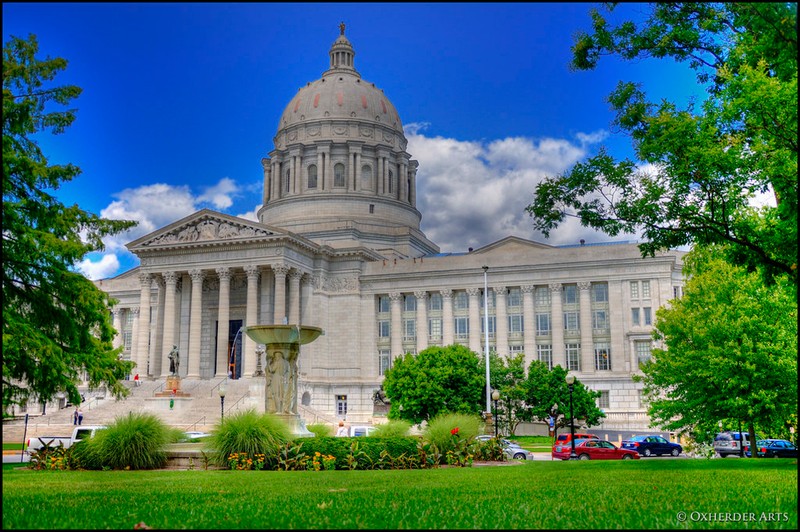"A Social History of the State of Missouri"
Introduction
Text-to-speech Audio
In 1936, Thomas Hart Benton finished A Social History of the State of Missouri which is on display at the state capitol in Jefferson City. State senator Ed Barbour convinced the Missouri legislature to commission the artist to produce this work, with panels that depict diverse groups of Missouri residents including enslaved persons, industrial workers, farmers, and even members of Jesse James’ gang. The work is notable for including parts of the state’s history that were usually not included in the murals that were commissioned at this time which usually focused on boosterism and selective interpretations. Visitors can schedule tours of the capitol building, but they may see the mural only on certain days. Images of the work can be seen in the links below along with the Google Streetview image within this entry.
Images
The Missouri state capitol building

Backstory and Context
Text-to-speech Audio
Benton used the Jefferson City job as an opportunity to move from New York to Missouri. On May 28, 1935, the Missouri legislature passed a bill giving Benton $16,000, nearly $336,000 today, to paint the House Lounge. Benton used numerous sketches and models to plan the room meticulously. Despite public objections to the style and content, the mural has lasted as an important part of Missouri’s art history.
Benton continued his tradition of planning out every element of the mural. He knew that “you can’t change your mind up on the scaffold without the risk of everything going awry.”[1] He traveled to Missouri and sketched the people and places he saw. He used his students as models and created clay figures to help him understand the three-dimensional shapes. Benton refused to tell the government his plans because he feared censorship of his more controversial topics. He would not listen to any friends or colleagues who made suggestions.
Benton began painting the mural during the deathly hot 1936 summer. As he tried to keep his paints from thinning too much, visitors could freely enter the room and watch him work. Only then would he take feedback and correct mistakes viewers found, such as the size of a plow compared to a horse. Benton was willing to change his work if it made the piece more accurate. Removing criminals or nudity would only make the scene less realistic. Throughout his entire process, Benton believed that no one but himself understood his vision. Any outside influence would harm his work. Benton finished painting on December 19, 1936. The portrait of Missouri from its earliest days to the 1930s reflected Benton’s beliefs and life.
This masterpiece marked Benton’s full embrace of Regionalism and his detailed, flowing style. A panel above one door depicts Huckleberry Finn and Jim in Mark Twain’s Adventures of Huckleberry Finn (1884). Jesse James’ gang robs a bank above another door. The Indigenous Osage interact with traders. Industrial, farm, and slaughterhouse workers labor around the room. Political boss Tom Pendergast and real estate developer J.C. Nichols sit together. A mother changes her baby’s diaper at a political rally. In a smaller panel, a white overseer whips enslaved lead mine workers. Benton did not avoid the painful parts of Missouri history. He would not ignore slavery or political corruption because his financers told him. In his eyes, Benton uplifted the ordinary worker while criticizing those in power. He showed the facts of daily life.
A Social History is one of the best examples of Benton’s style. The artist said that “this realism tried to symbolize the turmoil of America by setting up a turmoil of rhythmic sequences.”[2] In other words, Benton did not think that the United States was perfect, as many critics claimed he did. Instead of making tidy paintings through repeating patterns, he created controlled chaos. He did not paint stationary scenes. The subjects almost seem to move, especially when their limbs cross dividing lines between panels. Overlapping everything forces viewers’ eyes to move constantly. Many thought the room was overwhelming. They immediately wanted to paint the walls Black or white. Benton had not wanted this room to be a place for people to sit and relax. He wanted visitors to think critically about what the building and room represented.
Benton always exercised complete control over his mural, and he refused to deviate from his chosen topics or style. He believed that overlapping positive and negative scenes truly portrayed Missouri history. Benton made Kansas City his home for the rest of his life and while he indicated a strong affection for the Midwest and painted numerous murals depicting the state in a positive light, he was also willing to include difficult topics such as slavery.
Sources
- Adams, Thomas Hart Benton: An American Original, 255.
- Adams, Thomas Hart Benton: An American Original, 262.
Adams, Henry. Thomas Hart Benton: An American Original. New York. Alfred A. Knopf, 1989.
Benton, Thomas Hart. An Artist in America. Edition 4. Columbia, MO. University of Missouri Press, 1983.
Wolff, Justin. Thomas Hart Benton: A Life. New York. Farrar, Straus and Giroux, 2012.
flickr.com/photos/oxherder/3837438888
